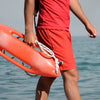A Lifeguard’s Uniform: The Essential Attire for Lifeguard
Lifeguards, entrusted with the paramount responsibility of ensuring water safety, don a distinctive uniform that embodies professionalism, visibility, and functionality. Let’s explore the components and significance of a lifeguard’s uniform, highlighting its role in promoting safety and swift response during aquatic emergencies.
Components of a Lifeguard’s Uniform:
1. Lifeguard Swimsuit:
• Lifeguards wear specialized swimsuits designed for comfort, flexibility, and ease of movement. These swimsuits often feature vibrant colors for high visibility, and some may have the word “Lifeguard” prominently displayed for identification.
2. Rash Guard or T-Shirt:
• Lifeguards may wear a rash guard or a T-shirt as an additional layer for sun protection and added visibility. These shirts often have the word “Lifeguard” or the facility’s logo printed on them.
3. Lifeguard Whistle:
• A whistle attached to a lanyard is an essential accessory for lifeguards. It serves as a communication tool, enabling lifeguards to signal warnings, attract attention, or convey instructions effectively.
4. Lifeguard Rescue Tube or Can:
• Lifeguards often carry a rescue tube or can to aid in water rescues. These flotation devices are essential for providing buoyancy and support during rescue operations.
5. Headgear:
• Some lifeguards wear hats or visors for sun protection, helping shield their eyes and face from glare while ensuring clear vision over the water.
6. Footwear:
• Water-resistant sandals or shoes provide grip and protection for lifeguards working around wet and slippery areas.
Significance of the Uniform:
1. Visibility and Identification:
• The distinct and brightly colored uniform worn by lifeguards enhances visibility, enabling beachgoers and swimmers to easily identify and seek assistance from a lifeguard.
2. Professionalism and Authority:
• The uniform symbolizes professionalism and authority, instilling confidence and trust in the lifeguard’s abilities to respond promptly to emergencies and maintain safety.
3. Functional Design:
• Each component of the lifeguard uniform is purposefully designed to ensure comfort, mobility, and functionality during surveillance and rescue operations.
Conclusion:
A lifeguard’s uniform is more than just clothing; it embodies professionalism, visibility, and functionality essential for ensuring water safety. From the specialized swimsuit to the whistle and rescue equipment, each component plays a crucial role in aiding lifeguards during emergencies and in their vigilant surveillance of aquatic environments.
By donning their distinct uniform, lifeguards signify their commitment to safeguarding lives and promoting safety in aquatic settings, standing as visible beacons of protection and assurance for individuals enjoying water activities.

